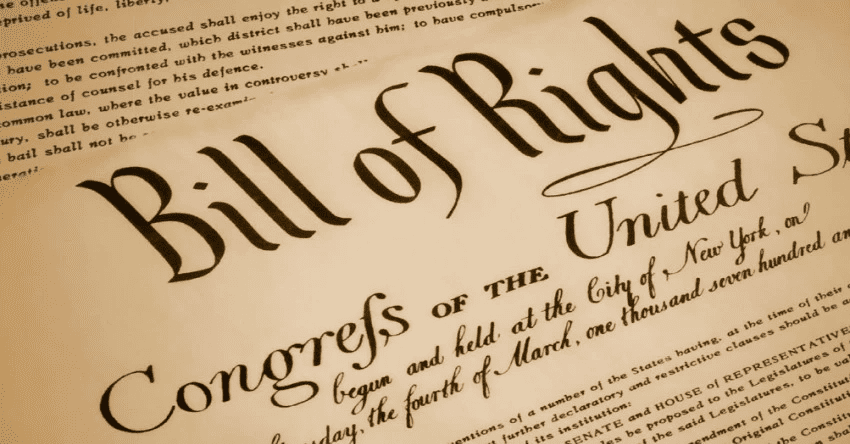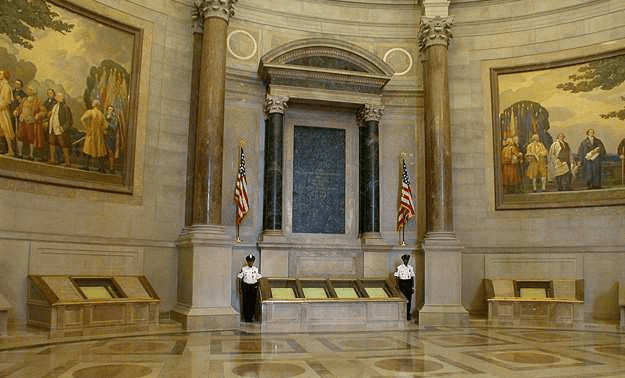

The first national election was in 1789. Along with President Washington, voters elected a lot of people that wanted the Constitution to be adopted. Almost half of the members of Congress that were there helped to write or ratify it. Keep reading to learn more Bill of Rights facts.
Only 8 people opposed the new Constitution. Most of them were not in the House of Representatives, but instead, they were fighting against it in state politics.
The new Congress had to decide how to change the Constitution. There were calls for changes during the ratification process. Important states like Massachusetts, Virginia, and New York (among others) supported the Constitution only if protection for individual rights was implemented.
Now that people who support the Constitution are also in charge of the government, what will they do? The first Congress made amendments to the Constitution, and the Bill of Rights became a part of it.
James Madison was the youngest member of the Continental Congress. He helped develop the American government. For example, he made the Virginia Plan, wrote some of the Federalist Papers, and wrote part of our Bill of Rights.
James Madison, a member of Congress from Virginia, was the one who wrote the proposed amendments to the Constitution. He found many examples and proposals from other state constitutions. He then chose nineteen of them to send to state legislatures for approval.
Madison was a nationalist who wanted to make sure the new central government would be strong. He made ten amendments, and they were all ratified in 1791.
The first ten amendments to the Constitution are known today also under the name Bill of Rights. They stand for individual liberty and limited government. Most of them concern legal protections for those who are accused of crimes.
The Bill of Rights sets rules for due process law and reserves all powers not delegated by the federal government to people or States. This specifies that “the enumeration in the Constitution, of certain rights, shall not be construed to deny or disparage others retained by people.”
The First Amendment of the United States Constitution provides several protections. This includes the right to express ideas by speaking or writing and gather with a group for different reasons.
The First Amendment also protects against the government establishing a religion. It protects the freedom to practice your religion. The government cannot make laws that target specific religious practices or put too much burden on people’s worship. Congress also has to let the media say what they want and allow people to protest in public.
People have the right to have a well-regulated militia. They can have arms too. It is vital for a free country not to take away this right.
The founders wanted to make sure that people were allowed to keep and protect themselves. They wanted people to be able to defend themselves against any threat, including tyranny. The Second Amendment was included in the Bill of Rights because many people were concerned about what would happen to their rights if they did not protect them.
The Third Amendment says that the federal government cannot force homeowners to let military people live in their houses. Before the Revolutionary War, legislation gave British soldiers the right to occupy private residences on behalf of the crown.
The Fourth Amendment protects you from unreasonable search and seizure. This means that the government can’t come to your house. They also can’t take anything away from you.
Officers can’t search your house or your body unless they have a good reason. They have to go to a judge first.
The Fifth Amendment protects people who are accused of crimes. It says that a grand jury must start severe criminal charges. The accused cannot be tried twice for the same crime, and they cannot have property taken away without just compensation.
The person also has the right against self-incrimination and has to be given fair procedures and trials, which protect them from being imprisoned without due process of law.
The Founding fathers believed that property was one of the natural rights. They protected this right by putting it in the Fifth Amendment. The government can take the property, but they have to pay for it.
The Sixth Amendment provides additional protections when you are accused of a crime, such as the right to have a public trial. You can have your witnesses and have a lawyer help you with the case.
If you are arrested, and then you are charged with a crime, you still have rights. You have the right to have your trial soon and in public so that everyone knows what is happening. A jury will then decide the case. This jury will be composed of civilians from where you live if that is what you wish.
You also have the right to know what you are accused of doing wrong and see the witnesses against you. You also have the right to a lawyer if you can’t afford one–and if not, then the government will pay for it.
The Seventh Amendment is about the right to a jury trial in federal civil cases, like lawsuits. It gives you the right to have a due process.
Due process means that the government must treat its citizens fairly. The government must follow laws and procedures when it wants to restrict or take away your rights, like your right to life, liberty, or property. This makes America a country where people are treated as equals because everyone’s rights are protected equally under the law.
The Eighth Amendment prevents people from being punished too much for crimes. It stops authorities from imposing excessive bail and fines and punishing people in ways too cruel or unusual. The Constitution guarantees you many rights, like the right to a fair trial and protection from cruel punishment.
The Ninth Amendment says that the list of rights in the Constitution does not mean people don’t have other rights. Americans value their freedom to make essential choices. They can do what they want to do, as long as it doesn’t hurt other people.
The Ninth Amendment is about people’s rights not listed in the first eight amendments or other places in the Constitution. This can make it hard to know what these rights are.
The Ninth Amendment is crucial for personal liberty. People think that the rights that are not listed in the Constitution are up to us to decide. This can be a problem because people are balancing personal liberty and democracy.
The Tenth Amendment says that if the Federal Government does not have the power in the Constitution to do something, then it belongs to the state government or individuals.
People disagree on how much power the government should have. For example, some people think that the state and national governments should do whatever they want. Others say that it is more important to divide power between and within governments. The Founders agreed on this: the federal system is a good idea for America.
The Founders wanted a government that was strong but not too powerful. One way they did this was to create a federal republic. The national government had specific powers, and the other ones were left with the states or the people.
The United States has two types of power. The national government and state governments can work together. The national government was given the power to do certain things, like to regulate commerce between the states, coin money, or raise armies. This is called a federal system.
The Federalists won the debate when the Constitution was ratified. Eight states submitted lists of proposed amendments that were approved, but there continued to call for a bill of rights. One amendment that was proposed by all was the principle now contained in the Tenth Amendment.
The founders included the Tenth Amendment to support the idea that the federal government is limited. The power that it doesn’t have, such as all powers not given, belongs to the states or people.

Today, anybody can visit these original founding documents for the United States in the Rotunda for the Charters of Freedom. These are important because they tell you about how the United States of America was founded and what it means to its citizens.
The three most important documents are known as “The Charters of Freedom.” They are:
Photography is not allowed at the National Archives. They are cautious about taking care of important documents like the Bill of Rights and other originals displayed in the National Archives Museum. They do this by not allowing flash photography or taking photos in any exhibition areas.
P.S. If you enjoyed what you read and are a teacher or tutor needing resources for your students from kindergarten all the way up to high school senior (or even adults!), check out our partner sites KidsKonnect, SchoolHistory, and HelpTeaching for hundreds of facts, worksheets, activities, quizzes, courses, and more!